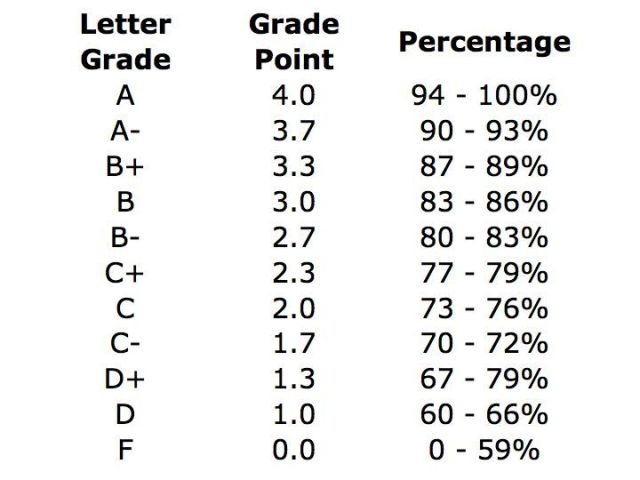Grade Point Average or GPA is an important metric used to measure a student’s academic performance in high school. It is calculated by taking the average of all the grades a student has received in their courses. GPAs can be presented in two forms: unweighted and weighted. In this article, we will focus on the latter, specifically on the concept of cumulative weighted GPA.
Cumulative weighted GPA is a variant of GPA that takes into account the difficulty level of the courses taken by the student. It assigns extra points to courses that are considered more challenging or advanced, such as Honors, Advanced Placement (AP), or International Baccalaureate (IB) courses. These extra points are added to the student’s grade point average, resulting in a higher overall score.
To better understand how cumulative weighted GPA is calculated, let’s first look at how a regular unweighted GPA is computed. In this system, each grade is assigned a numerical value from 0 to 4.0, based on a standard scale. A grade of A is worth 4.0, a B is worth 3.0, a C is worth 2.0, a D is worth 1.0, and an F is worth 0.0. The unweighted GPA is then calculated by taking the average of all thee numerical values, regardless of the difficulty level of the courses.
Cumulative weighted GPA, on the other hand, factors in the added rigor of advanced courses. For example, an A in an Honors or AP course may be worth 5.0 or 6.0, respectively, instead of the standard 4.0. This means that a student who takes advanced courses and earns good grades in them will have a higher cumulative weighted GPA than a student who takes only standard courses and earns the same grades.
It’s important to note that the exact scale used for weighted GPAs can vary depending on the school or district. Some schools may assign different point values to different levels of courses. Additionally, not all courses may be eligible for extra weighting, so it’s important to check with your school’s guidance office to understand how your GPA is calculated.
Colleges and universities often consider a student’s cumulative weighted GPA as part of the admissions process. It’s seen as an indicator of a student’s ability to handle challenging coursework and succeed in a competitive academic environment. However, it’s important to remember that GPA is just one factor that colleges consider, and they also look at other factors such as extracurricular activities, essays, and test scores.
Cumulative weighted GPA is a variant of GPA that factors in the difficulty level of the courses taken by the student. It assigns extra points to advanced courses, resulting in a higher overall score. This metric is often used by colleges and universities as part of the admissions process, but it’s important to remember that it’s just one factor among many.
Differences Between Cumulative GPA and Weighted GPA
When it comes to calculating a student’s Grade Point Average (GPA), there are different methods that schools use. Two common types of GPA are cumulative and weighted. Although both are used to determine a student’s academic performance, they are not the same.
A cumulative GPA is the average of all grades earned by a student throughout their academic career. This includes all courses, regardless of the level of difficulty or the type of class (e.g., regular, honors, AP, IB). The cumulative GPA is calculated by adding up all grades earned and dividing by the number of courses taken.
On the other hand, a weighted GPA takes into account the level of difficulty of the courses taken. This means that courses that are considered more challenging, such as honors, AP, or IB, are given extra weight. For example, an A in an honors course may be worth 4.5 or 5.0 instead of the standard 4.0 that an A in a regular course would be worth. The weighted GPA is calculated by adding up the weighted grade points earned and dividing by the number of courses taken.
While the cumulative GPA is the average of all grades earned, the weighted GPA takes into account the level of difficulty of courses taken. It is important to note that not all schools use a weighted GPA system, and some may use a different method altogether.

Do Colleges Consider Weighted or Cumulative GPA?
When it comes to evaluating a student’s academic performance, colleges take into account both the unweighted (cumulative) and weighted GPA. The unweighted GPA is calculated based on a 4.0 scale and considers all classes to be equal in value. On the other hand, the weighted GPA is calculated on a 5.0 scale and takes into consideration the difficulty level of the courses taken.
Colleges consider both types of GPAs when reviewing applications for admission, as they want to understand a student’s overall academic performance as well as their ability to take on challenging courses. The weighted GPA can provie insight into a student’s willingness to take on difficult coursework and their ability to excel in those classes.
However, it is important to note that not all high schools offer weighted GPAs, so colleges will also consider the unweighted GPA as a primary indicator of academic performance. Additionally, colleges may also consider other factors, such as class rank, standardized test scores, and extracurricular activities, when evaluating a student’s application.
Both the weighted and cumulative (unweighted) GPA are important factors that colleges consider when evaluating a student’s academic performance. While the weighted GPA can provide insight into a student’s ability to take on challenging coursework, the unweighted GPA is still a primary indicator of academic performance and is taken into account by colleges in the admissions process.
Weighting of Cumulative GPA in College
In college, cumulative GPA can be either weighted or unweighted, depending on the institution’s policies. Weighted GPA takes into account the difficulty level of a student’s coursework, while unweighted GPA does not. A weighted GPA can be higher than a 4.0, as it assigns additional points to grades earned in honors, AP, or other advanced courses. On the other hand, unweighted GPA is measured on a scale of 0 to 4.0, where an A is represented as a 4.0, regardless of the course level. It’s important to note that some colleges may recalculate GPAs usng their own weighting systems, so it’s essential to check with the specific institution for their policies on weighted vs. unweighted GPA.
Weighting of Cumulative GPA on a 4.0 Scale
Cumulative GPA on a 4.0 scale can be either weighted or unweighted, depending on the method used to calculate it. Unweighted GPAs are the most common and are calculated by giving equal weight to all classes, regardless of their level of difficulty. In this system, an A in an honors or advanced placement class is worth the same as an A in a regular class. The GPA is then calculated by dividing the total grade points earned by the total number of classes taken.
On the other hand, weighted GPAs take into account the level of difficulty of each class. In this system, an A in an honors or AP class is worth more than an A in a regular class. The GPA is calculated by adding up the total weighted grade points and dividing by the total number of classes taken. Weighted GPAs are oftn used to give credit to students who take more challenging courses and are typically reported on a 5.0 scale.
It’s important to note that each school or district may have its own method for calculating GPAs, so it’s important to check with your school’s guidance counselor to understand how your GPA is being calculated. Additionally, colleges and universities often have their own method for calculating GPA, so it’s important to understand how your GPA will be viewed in the college application process.

Conclusion
The Cumulative GPA (Weighted) is a valuable tool for measuring a student’s academic achievements. It takes into account the difficulty of the coursework and povides a more accurate representation of a student’s academic performance. Colleges and universities consider both weighted and unweighted GPAs when evaluating applications for admission, so it’s important for students to strive for excellence in all of their classes. While unweighted GPAs are traditionally used, weighted GPAs provide a more comprehensive view of a student’s academic abilities. It’s important for students to work hard, take challenging courses, and maintain high grades to achieve a strong Cumulative GPA (Weighted) and increase their chances of success in the college application process.
